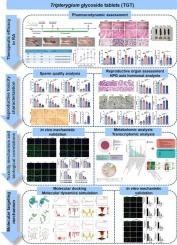Tripterygium glycoside tablet induces male reproductive toxicity in CIA rats by inhibiting the NELL2-Lumicrine system
IF 5.1
2区 医学
Q1 MEDICINE, RESEARCH & EXPERIMENTAL
引用次数: 0
Abstract
Aims
Tripterygium glycoside tablet (TGT), a first-line anti-inflammatory drug for rheumatoid arthritis (RA), is severely limited in clinical use by male reproductive toxicity with unclear mechanisms. This study aimed to confirm TGT's anti-RA efficacy, characterize its reproductive toxicity in collagen-induced arthritis (CIA) rats, and elucidate whether the NELL2-Lumicrine system mediates such damage.
Materials and methods
TGT's anti-inflammatory efficacy in CIA rats was evaluated via arthritis scoring, histopathology, and cytokine quantification. Male reproductive toxicity was assessed using sperm analysis, fertilization evaluation, histopathology, and hormone measurement. NELL2-Lumicrine system targets were identified by immunofluorescence and Western blot. Integrated metabolomic and transcriptomic analyses explored TGT's effects on testicular metabolism and gene expression. Molecular docking, dynamics simulation, and cell co-culture experiments verified inhibitory effects of TGT's bioactive components on the NELL2-Lumicrine system.
Key findings
TGT alleviated joint swelling, reduced arthritis scores, and decreased serum TNF-α/IL-1β in CIA rats. However, TGT impaired sperm quality and fertilization capacity, increased sperm/embryo abnormalities, and induced testicular-epididymal damage, with hypothalamic-pituitary-gonadal axis hormone dysregulation. Mechanistically, TGT downregulated NELL2 and downstream targets (ROS1, OVCH2, ADAM28, ADAM3), disrupting sperm maturation. Multi-omics revealed TGT disrupted testicular steroid biosynthesis and Fgf signaling linked to the NELL2-Lumicrine system. Computational modeling and in vitro experiments confirmed triptolide and triptonide bind NELL2 strongly, suppressing its signaling pathway.
Significance
Our data provide the first evidence that TGT induces male reproductive toxicity by inhibiting the NELL2-Lumicrine system, downregulating NELL2 and its downstream targets (ROS1, OVCH2, ADAM28, and ADAM3), which are essential for sperm maturation.

雷公藤糖苷片通过抑制NELL2-Lumicrine系统诱导CIA大鼠雄性生殖毒性
AimsTripterygium glycoside tablet (TGT)是一种治疗类风湿性关节炎(RA)的一线抗炎药物,由于其男性生殖毒性,其临床应用受到严重限制,机制尚不清楚。本研究旨在证实TGT抗ra的功效,表征其对胶原诱导关节炎(CIA)大鼠的生殖毒性,并阐明NELL2-Lumicrine系统是否介导了这种损伤。材料与方法通过关节炎评分、组织病理学、细胞因子定量等方法评价stgt对CIA大鼠的抗炎作用。通过精子分析、受精评估、组织病理学和激素测量来评估男性生殖毒性。通过免疫荧光和Western blot对NELL2-Lumicrine系统靶点进行鉴定。综合代谢组学和转录组学分析探讨了TGT对睾丸代谢和基因表达的影响。分子对接、动力学模拟和细胞共培养实验验证了TGT生物活性成分对NELL2-Lumicrine系统的抑制作用。stgt减轻CIA大鼠关节肿胀,降低关节炎评分,降低血清TNF-α/IL-1β。然而,TGT会损害精子质量和受精能力,增加精子/胚胎异常,诱导睾丸-附睾损伤,并伴有下丘脑-垂体-性腺轴激素失调。在机制上,TGT下调NELL2和下游靶点(ROS1, OVCH2, ADAM28, ADAM3),破坏精子成熟。多组学显示TGT破坏睾丸类固醇生物合成和与NELL2-Lumicrine系统相关的Fgf信号。计算模型和体外实验证实,雷公藤甲素和雷公藤甲素能强烈结合NELL2,抑制其信号通路。我们的数据首次证明TGT通过抑制NELL2- lumicrine系统,下调NELL2及其下游靶点(ROS1, OVCH2, ADAM28和ADAM3)来诱导男性生殖毒性,这些靶点对精子成熟至关重要。
本文章由计算机程序翻译,如有差异,请以英文原文为准。
求助全文
约1分钟内获得全文
求助全文
来源期刊

Life sciences
医学-药学
CiteScore
12.20
自引率
1.60%
发文量
841
审稿时长
6 months
期刊介绍:
Life Sciences is an international journal publishing articles that emphasize the molecular, cellular, and functional basis of therapy. The journal emphasizes the understanding of mechanism that is relevant to all aspects of human disease and translation to patients. All articles are rigorously reviewed.
The Journal favors publication of full-length papers where modern scientific technologies are used to explain molecular, cellular and physiological mechanisms. Articles that merely report observations are rarely accepted. Recommendations from the Declaration of Helsinki or NIH guidelines for care and use of laboratory animals must be adhered to. Articles should be written at a level accessible to readers who are non-specialists in the topic of the article themselves, but who are interested in the research. The Journal welcomes reviews on topics of wide interest to investigators in the life sciences. We particularly encourage submission of brief, focused reviews containing high-quality artwork and require the use of mechanistic summary diagrams.
 求助内容:
求助内容: 应助结果提醒方式:
应助结果提醒方式:


